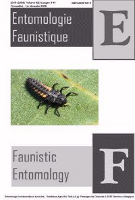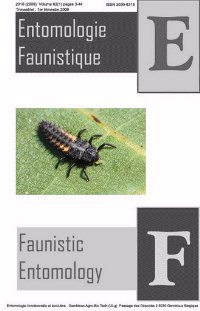Entomologie faunistique
AUTHORS GUIDELINES
Entomologie faunistique – Faunistic Entomology welcomes entomological papers in English and French. Any paperdealing with non Crustacean Arthropods in the domains of systematics, phylogeny, macro-, micro- ecology, biogeography,etc. -on the condition that they deal with consistent faunal entities- will be considered. The manuscripts will be original andnot submitted elsewhere.
The manuscripts will be submitted electronically as e- mail attachments. Submission addresses are:
Prof. Frédéric FRANCIS
Chief-Editor of Entomologie faunistique – Faunistic Entomology
University of Liege – Gembloux Agro-Bio Tech Unité d’Entomologie fonctionnelle et évolutive
Passage des Déportés, 2 – B-5030 Gembloux - Belgique E-mail address: entomofaunistique.gembloux@ulg.ac.be
Internet : http://popups.ulg.ac.be
The texts and tables must be submitted as .DOC, .DOCX ou .ODT
Figures and tables must be provided in a separate file in .JPG, .PNG, .GIF or.PNG. Layout of the article has to be restricted at the minimum, no using of style. Your submission do not exceed 16 MB.
The body of text is in Times New Roman 12.
Articles will have maximum 25 pages of text. Restrain from using footnotes. All the authors are expected to have read the entirety of the article and approve its submission for publication.
The content of the works published in Entomologie faunistique – Faunistic Entomology is upon the entire responsibility ofauthor(s).
EVALUATION AND PUBLICATION PROCESS
The reviewing Committee meets around 10 times a year. Before any evaluation, conformity to author’s guidelines, consistency with the purpose of the journal, respect of the electronic formats, language and writing quality are verified. Any non-conforming submission will be returned to the authors.
The committee members will assign two reviewers based on their competencies and absence of link with the research authors. The authors may recommend reviewers with which they agree not make contact.
The evaluations of the reviewers will be send to the secretariat of the journal and discussed during the Reviewing Committee meeting. The process of evaluation/improvements transit via the secretariat of the journal.
Once a submitted article is accepted for publication in Entomologie faunistique – Faunistic Entomology, a formatted copy will be send by the editor to the author for a final review and modifications. This ultimate corrected version will be sent back to the editor with approval for publication.
The authors provide the journal the right for the first publication, in open-access, under Licence d’attribution Creative Commons (CC) BY-SA, allowing others to share/modify it, while recognising authorship, precedence of the publication and the obligation to distribute it under the same license. Authors maintain the copyrights at all times.
MANUSCRIPT LAYOUT
Badly presented manuscript can be refused independent of the terms in the referees’ reports.
Manuscripts should be organised as follow:
Title page
The title page should contain: the title (informative and concise), the complete names, surnames and addresses of the authors.The corresponding author should be designated by a "*"and e-mail address of that latter author is required.
Abstracts and key-words
Abstracts are required in French and English. They shouldn't be longer than 250 words each. For the non native speakerauthors, the editorial team could propose for free a translation of the provided abstract.
The abstracts will be followed by four to eight key- words (in English), which are expected to express the main themesin the paper.
Abstracts and key-words will be organised on a second page.
Body of the text
Research articles
The text should be subdivided in the following chapters: "Introduction", "Material and Methods", "Results", "Discussion"and "Conclusions" (facultative). According to the paper own specificities, results and discussion chapters, as well asdiscussion and conclusions, could be lumped. The results chapter could also be substituted by a "Comments" chapter.Acknowledgements should be given after the conclusions chapter.
Taxonomic articles ( identification, revision, description, identification keys)
The taxonomic descriptions will also be subdivided by short titles: Head, Mesosoma/Thorax, Metasoma/Gastre, Genitalparts (e.g.).
The quotation of taxa must follow the international rules of nomenclature (ICZN). The abbreviations underliningtaxonomical changes are sp. nov., g. nov., comb. nov. The use of "," between the authority and date should be avoided.The authorities could be shortened, following the usage in the studied taxon and only if not ambiguous.
Article of refrence summary
The text is structures as follow: Introduction, Litterature, Conclusion.
Brief Communication
The text should not have more then 1200 words, and will have the same structure as research and taxonomic articles without the Conclusion part. A short communication won't include a summary and will be three-page long (maximum).
References
The authors are encouraged to cross the references quoted in the text and those of the references chapter. All the referencesquoted in the text must appear in the chapter and reciprocally.
The listed references should be given in alphabetical order of the first author names and chronologically. The single authorpapers should be listed first. The journal names must be given in full length.
Quoting books, the next information are compulsory author(s), year, title, editor, publication place, edition and pagenumber.
The conference proceedings will be quoted as monographs. The reference line will include in that case the place and date ofthe meeting, the names of the scientific editors.
The website references should include the date of the last visit.
Papers in press or accepted can be referred to, but not the papers in preparation or submitted.
We invite the authors to consult the author’s guidelines provided by the BASE review: http://www.pressesagro.be/ojs/index.php/base/about/submissions#authorGuidelines
The references should be presented as follow (with 0.5 cm of negative increment):
Papers in journal
Liénard V., Seck D., Haubruge E. & Gaspar C. 1992. Biologie de Caryedon pallidus (Oliv., 1790) (Col. Bruchidae),ravageur des graines de Cassia occidentalis (L.). Bulletin et Annales de la Société royale belge d'Entomologie 128, p. 339-342.
Books
Bernard F. 1968. Les fourmis (Hymenoptera Formicidae) d'Europe occidentale et septentrionale. Masson, Paris, 411 p.
Book chapter
Séguy E. 1951. Ordre des Diptères. In Grassé P.P. (éd.), Traité de Zoologie, vol. 10. 449-774. Masson et Cie, Paris.
Proceedings
Champ B.R. 1984. Pesticide resistance in stored product insects. In Champ B.R. (ed.), Proceedings of the AustralianDevelopment Assistance Course on the Preservation of Stored Cereals, Canberra, Australia, 1981, p. 681-690.
Ph-D
Gaspar C. 1970. Les formicides de la Famenne. Une monographie faunique régionale. Thèse de doctorat, Faculté desSciences agronomiques de Gembloux, Belgique, 253 p.
Website
Balenghien T. et al., 2008. Culicoides chiopterus: confirmation of its status as potential vector of bluetongue virus in Europe, http://www.promedmail.org, archive number 20080403.1222, (27/05/2014).
Borkent A., 2012. World species of biting midges (Diptera: Ceratopogonidae), http://wwx.inhs.illinois.edu/files/8413/4219/9566/CeratopogonidaeCatalog.pdf, (27/05/2014).
Tables and figures
Tables and figures should be assembled in a distinct file and numbered with Arabic characters. The legend will be grouped onthe same file last page.
Tables and figures are quoted in the text like (Table 2) or (Tables 3-4) and (Figure 5) or (Figures 5-6) in bold characters.The legends must be informative and concise.
Tables
To design a table, it is asked to use only the 'insert table' menu in the text editor. Tables cannot be set up using tabs ordrawing functions.
Figures
The artworks should be in black on white background. The pictures will be provided in JPG, .PNG, .GIF ou .PNG, with a resolution comprise of 150 dpi, size minimum 480 pixels and maximum 4000 pixels.
For graphics : axes label should be in conformity with the text, followed with measurements in parenthesis, and placed at an identical distance for all graphics.
The charts must be realised using a chart editor and provided to editor as a TIFF (picture) file.
The article will be formatted by us.
GENERAL LAYOUT
The submission format is DIN A4. Text must be in Times New Roman, 12pts.
Margins are 2.5cm left, right and top. The bottom margin is 1.6cm. Paragraphs must justified left and right. Tabs must beavoided.
Pages must be numbered in head on right. Papers should be no more than 25 printed pages long.
Footnotes can be used when justified. Insertion must use the text editor menu: 'insert footnote'.
The scientific names must be written in italic. The first reference to a species should involve the authority and the publication date WITHOUT a separation comma.
Sometimes symbol does not appear or change when putting it on the website. Please avoid special charaters if you can.
The number from one to ten must be spelled, except for measurement followed by unit or a sample size. Starting asentence, numbers are always spelled. The numerical data (stats e.g.) must be rounded in regard of relevance supported by thedata. Within text, units should be spelled, except if preceded by a number. In that latter case, the international abbreviationwill be used (min, g, m, j e.g.). Dates in records will be quoted as: dd.mm (in roman notation).yyyy: 12.vi.1980.
References are quoted in the text by the author names followed by the publication year. The author names are linked by '&'for two authors. In case of more than two authors, the first author name is followed by et al. in italic. When quoting severalreferences, they are separated by ';'. For one author, several dates are chronologically organised and separated by ','.
Example: (Jones, 1957; Ales, 1968; Guillaume, 1980, 1982; Giga & Smith, 1983; Jacobs et al., 1999; Wolff, 1999; Colsonet al., 2001).





